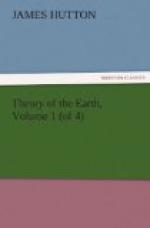We are thus led to suppose, that some parts of our earth may have undergone the vicissitudes of sea and land more than once, having been changed from the summit of a continent to the bottom of the sea, and again erected, with the rest of that bottom, into the place of land. In that case, appearances might be found to induce natural philosophers to conclude that there were in our land primary parts, which had not the marine origin which is generally to be acknowledged in the structure of this earth; and, by finding other masses, of marine origin, superincumbent upon those primary mountains, they might make strange suppositions in order to explain those natural appearances.
Let us now see what has been advanced by those philosophers who, though they term these parts of the earth primordial, and not primitive, at the same time appear to deny to those parts an origin analogous to that of their secondary mountains, or strata that are aquiform in their construction.
M. de Luc, after having long believed that the strata of the Alps had been formed like those of the low countries, at the bottom of the sea, gives an account of the occasion by which he was first confirmed in the opposite opinion.[26] Like a true philosopher, he gives us the reason of this change.
[Note 26: Lettres Physique et Morales sur l’Histoire de la Terre, tom. 2. pag. 206.]
“Ce fut une espece de montagne tres commune, et que j’avois souvent examinee qui dessilla mes yeux. La pierre qui la compose est de la classe appellee schiste; son caractere generique est d’etre feuilletee; elle renferme l’ardoise dont on couvre les toits. Ces feuillets minces, qu’on peut prendre pour des couches, et qui le font en effet dans quelques pierres de ce genre, rappelloient toujours l’idee vague de depots des eaux. Mais il y a des masses dont la composition est plutot par fibres que par feuillets, et dont le moellon ressemble aux copeaux de bois d’un chantier. Le plus souvent aussi les feuillets sont situes en toute suite de sens dans une meme montagne, et quelquefois meme verticalement, Enfin il s’en trouve de si tortilles, qu’il est impossible de les regarder comme des depots de l’eau.




